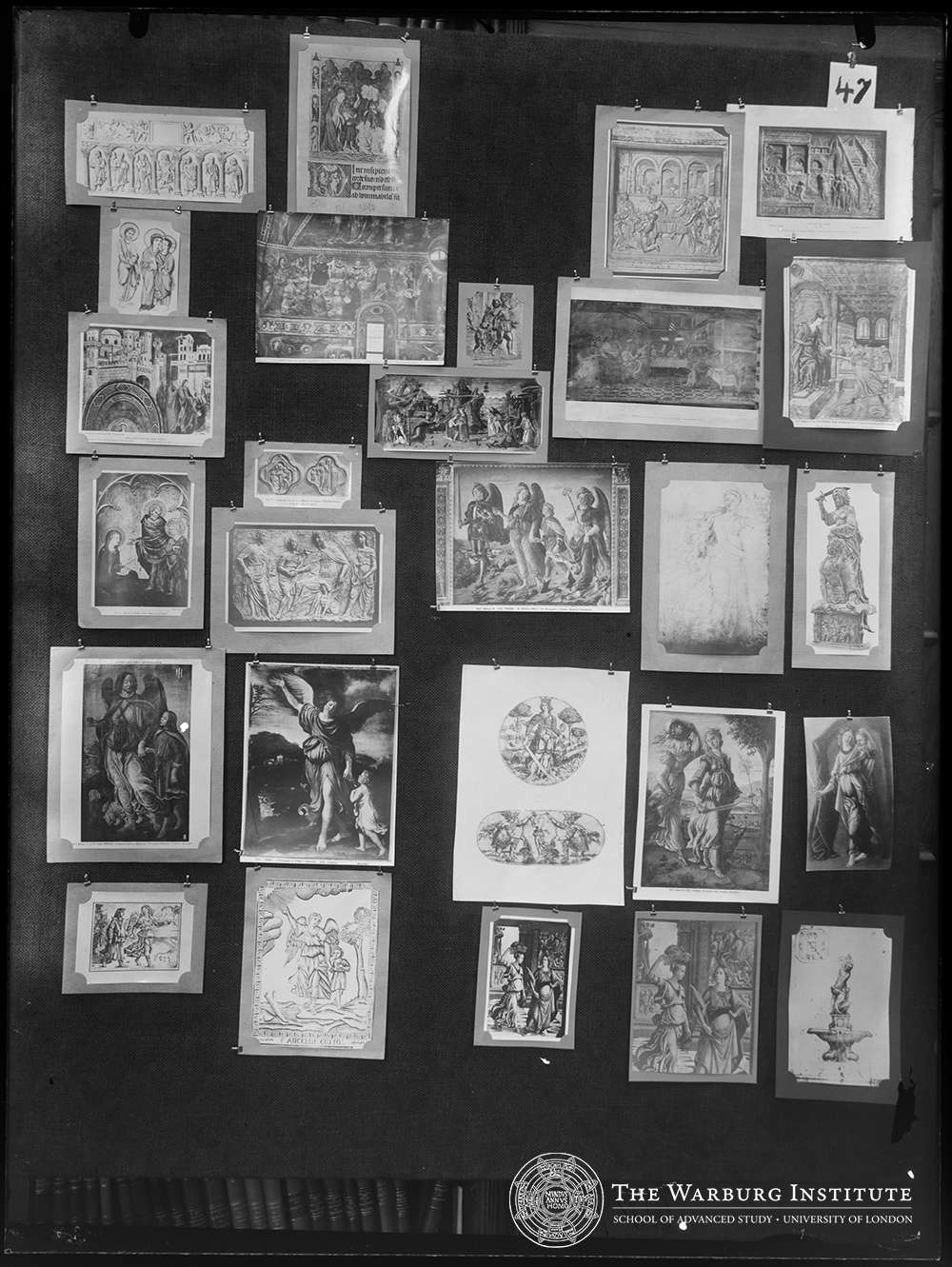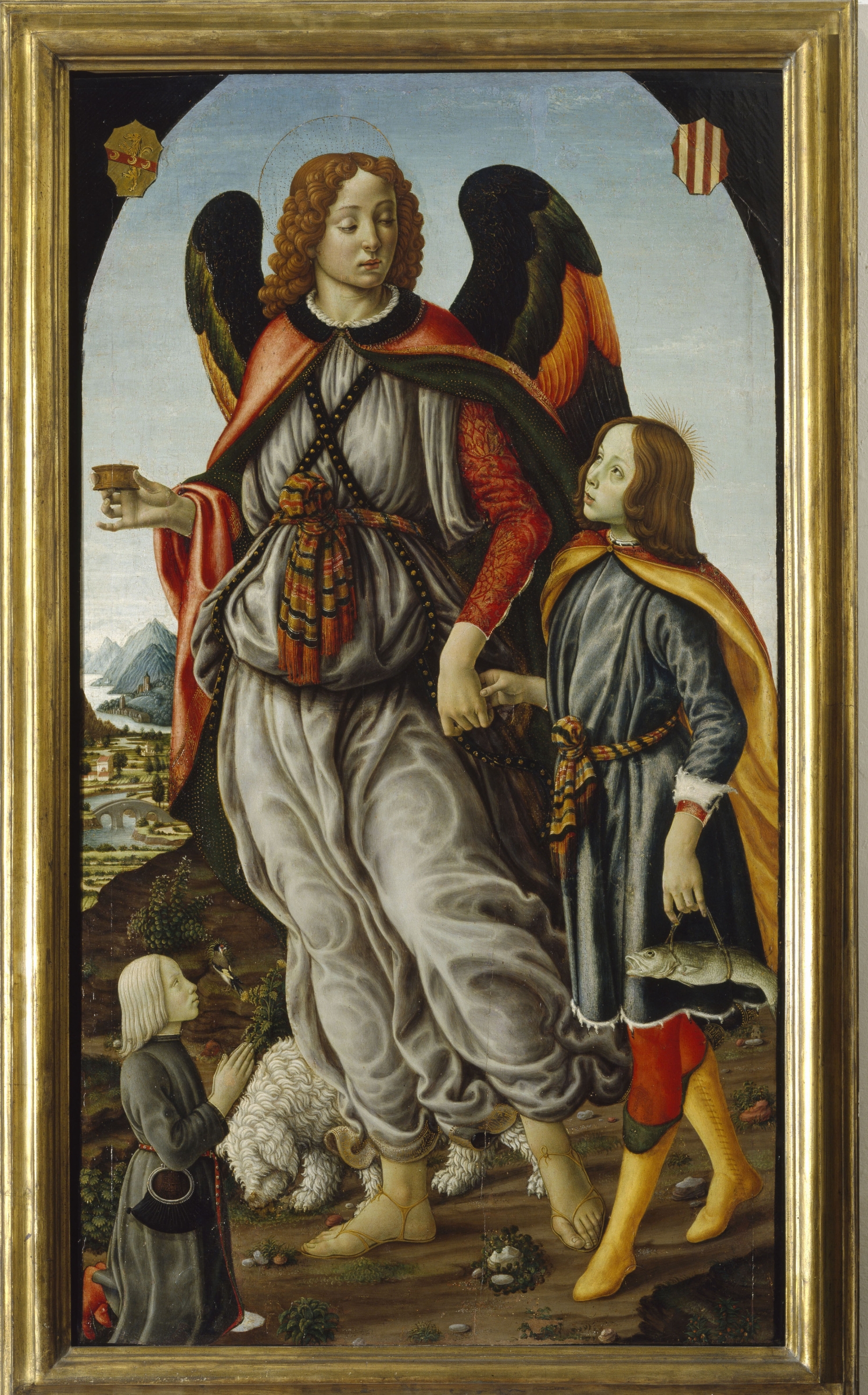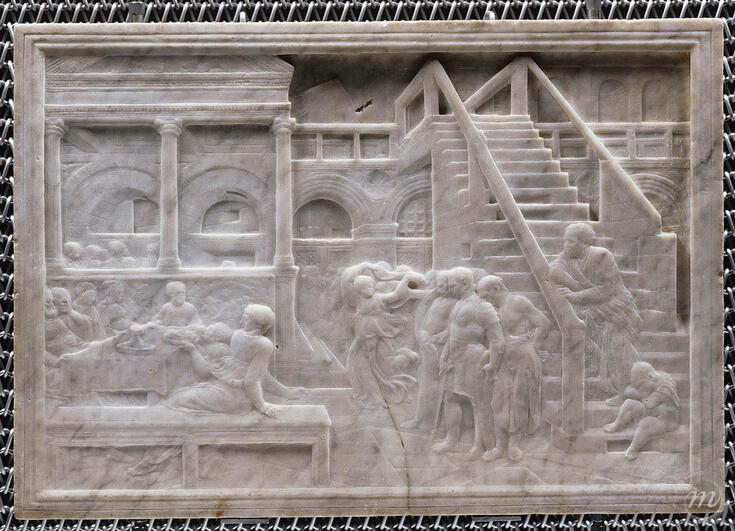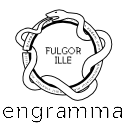Mnemosyne Atlas 47
Due volti della Ninfa: l’angelo e la cacciatrice di teste
Altre reincarnazioni della Ninfa in opposte figure di protezione o di furia distruttiva: l’angelo custode e la ‘cacciatrice di teste’ (Giuditta, Salomè, l’ancella che porta la testa mozzata). Il tema della protezione dei piccoli (Tobia e l’Angelo come immagine votiva per i figli dei mercanti) è presente anche in soggetti biblici (la scena evangelica del Ritorno a casa dal Tempio).
Two faces of the Nymph: the Angel and the Head-huntress
Further reincarnations of the Nymph in opposing figures of protection or destructive fury: the guardian angel and the head-huntress (Judith, Salome, a handmaiden carrying the severed head). The theme of the protection of children (Tobias and the Angel as a votive image for the children of merchants) is also present in Biblical subjects (the Gospel scene On the way home from the Temple).

Appunti di Aby Warburg (1929)
Judith. Herodias
Giuditta, Erodiade.
Appunti di Aby Warburg e collaboratori (1929)
Ninfa als Schutzengel und als Kopfjägerin. Herbeitragen des Kopfes. “Heimkehr vom Tempel” als Schutz des Kindes in der Fremde (Tobiuzzolobilder als Votivbilder).
Ninfa come angelo custode e come cacciatrice di teste. Trasporto della testa. “Ritorno a casa dal Tempio” come protezione del bambino nel mondo esterno (immagini di Tobiolo come immagini votive).
Appunti di Gertrud Bing (1940 ca)
Tobias – Judith (Salome). Das Beschützen + freundlich. Begleiten in derselben formalen Configuration wie das Verderben – Tragen. Heilvorgang + Vernichtungsvorgang. Innerhals des Tobias-Motivs wie der 2 Versionen: 12 Jähr Jesus im Tempel + Heimkehr – Tobias selbst. Zusammenhang das schützende Begleiten. Tobias wird auf seinem Auszug vom Engel begleitet (Funktion in Florenz bei d. Reisen der jungen Kaufmanns Lehrlinge). Heimkehr vom Tempel ist noch ein letztes Schutz vor der Trennung, die Trennung ist aber schon drin. Das Agostino di Duccio – Relief ist ein Abschiednehmen (wessen von wem?). Judith-Salome = “Kopfjägerinnen”. Der Mänadische Tanz bei Salome. Das Herauftragen des Hauptes wie das des Früchtekorbes bei d. Geburtsszene. Donatello beherrschte Geste, Ungezügeltheit nur in d. Putten-Relief.
Tobia – Giuditta (Salomè). Il proteggere + accompagnare amichevolmente nella stessa configurazione formale dell’uccidere – trasportare. Processo di protezione + Processo di distruzione. È come ci fossero due versioni nel motivo di Tobia: Gesù dodicenne al tempio + Ritorno a casa – Tobia stesso. La connessione è l’accompagnare proteggendo. Tobia nella sua partenza è accompagnato dall’angelo (a Firenze, funzione per il viaggio dei giovani apprendisti mercanti). Il ritorno a casa dal tempio è un’ultima protezione prima della separazione, ma la separazione vi è già inclusa. Il rilievo di Agostino di Duccio è un addio (da chi a chi?). Giuditta – Salomè = “Cacciatrici di teste”. La danza menadica in Salomè. Il trasporto della testa come quello della cesta di frutta nella scena della natività. Gesto controllato di Donatello, sfrenatezza solo nel rilievo dei putti.
Letture di approfondimento
♦ Seminario Mnemosyne, Letture grafiche di Tavola 47, “La Rivista di Engramma” 20, ottobre 2002 [IMPAGINAZIONE ORIGINALE].
Letture di approfondimento
♦ K. Mazzucco, G. Targia, Tavola 47, in Camere con vista. Aby Warburg, Firenze e il laboratorio delle immagini, Catalogo della mostra (Firenze, Gallerie degli Uffizi, 19 settembre / 10 dicembre 2023), a cura di M. Faietti, E.D. Schmidt, G. Targia, G. Wolf et al., Firenze 2023, 146-149.
Notes by Aby Warburg (1929)
Judith. Herodias
Judith, Herodias.
Notes by Aby Warburg and coll. (1929)
Ninfa als Schutzengel und als Kopfjägerin. Herbeitragen des Kopfes. “Heimkehr vom Tempel” als Schutz des Kindes in der Fremde (Tobiuzzolobilder als Votivbilder).
Nymph as protective angel and head-huntress. The bringing of the head. “The Return from the Temple” as protection of the child when abroad (pictures of young Tobias as votive images).
Notes by Gertrud Bing (ca. 1940)
Tobias – Judith (Salome). Das Beschützen + freundlich. Begleiten in derselben formalen Configuration wie das Verderben – Tragen. Heilvorgang + Vernichtungsvorgang. Innerhals des Tobias-Motivs wie der 2 Versionen: 12 Jähr Jesus im Tempel + Heimkehr – Tobias selbst. Zusammenhang das schützende Begleiten. Tobias wird auf seinem Auszug vom Engel begleitet (Funktion in Florenz bei d. Reisen der jungen Kaufmanns Lehrlinge). Heimkehr vom Tempel ist noch ein letztes Schutz vor der Trennung, die Trennung ist aber schon drin. Das Agostino di Duccio – Relief ist ein Abschiednehmen (wessen von wem?). Judith-Salome = “Kopfjägerinnen”. Der Mänadische Tanz bei Salome. Das Herauftragen des Hauptes wie das des Früchtekorbes bei d. Geburtsszene. Donatello beherrschte Geste, Ungezügeltheit nur in d. Putten-Relief.
Tobias – Judith (Salome). Protect + friendly accompany in the same formal configuration as kill – transport. Process of protection + Process of destruction. It is as if there were two versions in the Tobias motif: twelve-year-old Jesus at the temple + Returning home – Tobias himself. The connection is the accompanying by protecting. Tobias in his departure is accompanied by the angel (in Florence, a function for the journey of the young merchant apprentices). The return home from the temple is a final protection before separation, but separation is already in it. Agostino di Duccio’s relief is a farewell (from whom to whom?). Judith – Salome = “Headhunters”. The menadic dance with Salome. The carrying of the head like that of the basket of fruit in the nativity scene. Donatello’s controlled gesture, wildness only in the relief of the putti.
Further Readings
♦ Seminario Mnemosyne, Letture grafiche di Tavola 47, “La Rivista di Engramma” 20, ottobre 2002 [OLD LAYOUT].
Other Readings
♦ K. Mazzucco, G. Targia, Tavola 47, in Camere con vista. Aby Warburg, Firenze e il laboratorio delle immagini, Catalogo della mostra (Firenze, Gallerie degli Uffizi, 19 settembre / 10 dicembre 2023), a cura di M. Faietti, E.D. Schmidt, G. Targia, G. Wolf et al., Firenze 2023, 146-149.

1. Cristo, Ecclesia e apostoli, disegno da un bassorilievo su un sarcofago del sec. IV d.C. riutilizzato per la tomba di Sant'Egidio , Perugia, Chiesa di San Bernardino.
2. Ritorno di Gesù dai suoi genitori, riproduzione di un' illustrazione da Gregorio Nazianzeno, Omelie, manoscritto del sec. IX, Paris, Bibliothèque Nationale, ms. gr. 510, fol. 165r.
3. Scuola di Giotto, Fuga in Egitto, affresco, 1330 ca., Assisi, San Francesco, Basilica inferiore.
4. Simone Martini, Il ritorno di Gesù dai genitori, tempera su legno, 1342, Liverpool, Walker Art Gallery.
5. Gesù tra i dottori, miniatura dal cosiddetto "Queen Mary's Psalter", 1310-1330 ca., London, The British Library, Royal Ms. B VII, fol. 150v.
6. Maestro di Tolentino (o della Cappella di S. Nicola), Gesù tra i Dottori, Maria e Giuseppe lasciano il tempio con Gesù, affresco, 1340-1348,Tolentino, Chiesa di S. Nicola.
7. Bartolomeo Bellano, Giudizio di Salomone (particolare), bassorilievo in bronzo, 1484-1488, Padova, Chiesa di Sant'Antonio.
8a-8b. Gesù tra i Dottori. Il ritorno della sacra famiglia dall'Egitto, bassorilievi dallo zoccolo della facciata ovest della Cattedrale di Amiens, 1220-1230, Portale di Maria, Cattedrale di Amiens.
9. Agostino di Duccio (attribuzione), Il congedo di Cristo dalla madre (?), bassorilievo, 1473 ca., New York, Metropolitan Museum of Art.
10. Francesco Botticini, Tobia e l'Arcangelo Raffaele con giovane donatore (figlio del committente Raffaello Doni), tempera su legno, 1495 ca., Firenze, Santa Maria del Fiore, Sacrestia vecchia.
11. Giulio Campagnola, Tobia e l'angelo Raffaele, acquaforte su rame, 1500 ca.
12. Guercino, Tobia e l'angelo Raffaele, olio su rame, 1624-1626, Roma, Galleria Colonna.
13. Tobia e l'angelo, stampa da Giorgio Nicodemi, I legni incisi dei Musei Bresciani, Brescia 1921, p. 32.
14. Jacopo del Sellaio, Scene dalle vite dei santi. Tobia e l'angelo (a destra), cassone, seconda metà del sec. XV, Göttingen, Universitätsmuseum.
15. Francesco Botticini, Tobia e i tre Arcangeli, tempera su tavola, 1467, Firenze, Galleria degli Uffizi.
16. Donatello, Salomè dinanzi al banchetto di Erode, bassorilievo in bronzo, 1423-1427, Siena, Battistero, fonte battesimale.
17. Donatello, Salomè danza per Erode, bassorilievo in marmo, 1435 ca., Lille, Musée des Beaux-Arts.
18. Filippo Lippi, Salomè danza per Erode, affresco, 1464 ca., Prato, Duomo, parete sud del coro.
19. Antonio Pollaiuolo (autore del disegno), Erodiade riceve il capo di S. Giovanni Battista, paliotto d'altare con ciclo delle Storie del Battista , 1470 ca., Firenze, Museo dell'Opera del Duomo.
20. Giuditta con la testa di Oloferne, disegno di anonimo.
21. Donatello, Giuditta e Oloferne, bronzo, 1446-1460, Firenze, Piazza della Signoria.
22a. Giuditta con la testa di Oloferne, acquaforte fiorentina su rame, 1465 ca., London, The British Museum.
22b. Due soldati reggono uno scudo con la personificazione della Speranza, acquaforte fiorentina su rame, 1465 ca., London, The British Museum.
23. Sandro Botticelli, Giuditta torna dall'accampamento con il capo di Oloferne, tempera su tavola, parte di un dittico, dipinto, 1470 ca., Firenze, Galleria degli Uffizi.
24. Sandro Botticelli, Giuditta con la testa di Oloferne, tempera su tavola, 1497-1500 ca., Amsterdam, Rijksmuseum.
25a. Scuola del Ghirlandaio, Giuditta con la testa di Oloferne, olio su tavola, 1489, Berlin, Staatliche Museen, Gemäldegalerie.
25b. Scuola del Ghirlandaio, Giuditta con la testa di Oloferne, particolare, olio su tavola, 1489, Berlin, Staatliche Museen, Gemäldegalerie.
26. Pianta e prospetto di una fontana con Sansone uccide un Filisteo di Giambologna, disegno a penna, 1601 ca., Firenze, G
1.1. Christ, Ecclesia and Apostles, drawing from a sarcophagus’ bas-relief, sec. IV, reused for the grave of Saint' Egidio, Perugia, San Bernardino.
2. Christ returns to his parents, reproduction of an illustration in the book of "Omelie" by Gregorius Nazianzenus, manuscript, sec. IX, ms. gr. 510, fol. 165r, Paris, Bibliothèque National.
3. Giotto’s school, Flight into Egypt, fresco, c. 1330, Assisi, San Francesco, Lower Basilica.
4. Simone Martini, The return of Christ to his parents, tempera on panel, 1342, Liverpool, Walker Art Gallery.
5. Christ among the doctors, miniature from "Queen Mary's Psalter", 1310-1330, Royal Ms. B VII, fol. 150v, The British Library.
6. Maestro di Tolentino or Maestro della Cappella di San Nicola, Christ among the Doctors, Maria and Giuseppe leave the temple, fresco, 1340-1348, Tolentino, Church of San Nicola.
7. Bartolomeo Bellano, The judgment of Salomon (detail), bronze bas-relief, 1484-1488, Padova, Basilica of Sant' Antonio.
8a.-8b. Christ among the Doctors. The Return of The Holy Family from Egypt, bas-relief from the basament of the Cathedral of Amiens, 1220-1230, Portal of Maria, Amiens Cathedral.
9. Agostino di Duccio (attribuited), Christ taking leave of his mother (?), bas-relief, c. 1473, New York, Metropolitan Museum of Art.
10. Francesco Botticini, Tobias and the Angel, and the young donor (son of the patron Raffaello Doni), tempera on panel, c. 1495, Firenze, Santa Maria del Fiore, Sacrestia vecchia.
11. Giulio Campagnola, Tobias and the Angel Raphael, etching on copper, c. 1500.
12. Guercino, Tobias and the Angel Raphael, oil on copper, 1624-1626, Roma, Galleria Colonna.
13. Tobias and the Angel, print by Giorgio Nicodemi, in I legni incisi dei Musei Bresciani, Brescia 1921, p. 32.
14. Jacopo del Sellaio, Scenes from the lives of the saints. Tobias and The angel (to the right), chest, second half of 15th century, Göttingen, Universitätsmuseum.
15. Francesco Botticini, The three Archangels and Tobias, tempera on panel, 1467, Firenze, Galleria degli Uffizi.
16. Donatello, Salomè dancing at the Feast of Herod, bronze bas-relief, 1423-1427, Siena, Battistero, baptismal font.
17. Donatello, Salomè dancing before Herod, marble bas-relief, c. 1435, Lille, Musée des Beaux-Arts.
18. Filippo Lippi, Salomè dancing before Herod, fresco, c. 1464, Prato, Duomo, south wall of the chancel.
19. Antonio Pollaiuolo, Herodias receives the Head of Saint John the Baptist, altar's frontal with cycle of The Stories of The Baptist, Firenze, Museo dell'Opera del Duomo.
20. Judith holding Holofernes‘ head, drawing of anonymous.
21. Donatello, Judith and Holofernes, bronze, 1446-1460, Firenze, Piazza della Signoria.
22a. Judith holding Holofernes‘ head, etching on copper, c. 1465, London, The British Museum.
22b. Two soldiers hold up a shield with the personification of Hope, etching on copper, c. 1465, London, The British Museum.
23. Sandro Botticelli, The Return of Judith, tempera on panel, part of a dyptich, c. 1470, Firenze, Galleria degli Uffizi.
24. Sandro Botticelli, Judith holding Holofernes‘ head, tempera on panel, 1497-1500, Amsterdam, Rijksmuseum.
25a. Ghirlandaio’s workshop, Judith holding Holofernes‘ head, oil on panel, 1489, Berlin, Staatliche Museen, Gemäldegalerie.
25b. Ghirlandaio’s workshop, detail of Judith holding Holofernes‘ head, oil on panel, 1489, Berlin, Staatliche Museen, Gemäldegalerie.
26. Plant and prospect of a fountain with Samson kills a Philistine by Giambologna, pen drawing, c. 1601, Firenze, Gabinetto Disegni e Stampe degli Uffizi.


1. Cristo, Ecclesia e apostoli, disegno da un bassorilievo su un sarcofago del sec. IV d.C. riutilizzato per la tomba di Sant'Egidio , Perugia, Chiesa di San Bernardino.
1. Christ, Ecclesia and Apostles, drawing from a sarcophagus’ bas-relief, sec. IV, reused for the grave of Saint' Egidio, Perugia, San Bernardino.

2. Ritorno di Gesù dai suoi genitori, riproduzione di un' illustrazione da Gregorio Nazianzeno, Omelie, manoscritto del sec. IX, Paris, Bibliothèque Nationale, ms. gr. 510, fol. 165r.
2. Christ returns to his parents, reproduction of an illustration in the book of "Omelie" by Gregorius Nazianzenus, manuscript, sec. IX, ms. gr. 510, fol. 165r, Paris, Bibliothèque National.

3. Giotto, Ritorno della Sacra Famiglia a Gerusalemme, affresco, 1330 ca., Assisi, San Francesco, Basilica inferiore.
3. Giotto, The Return of the Holy Family in Jerusalem, fresco, 1330 ca.,Assisi, San Francesco, Lower Basilica.

4. Simone Martini, Il ritorno di Gesù dai genitori, tempera su legno, 1342, Liverpool, Walker Art Gallery.
4. Simone Martini, The return of Christ to his parents, tempera on panel, 1342, Liverpool, Walker Art Gallery.

5. Gesù tra i dottori, miniatura dal cosiddetto "Queen Mary's Psalter", 1310-1330 ca., London, The British Library, Royal Ms. B VII, fol. 150v.
5. Christ among the Doctors, miniature from "Queen Mary's Psalter", 1310-1330 ca., Royal Ms. B VII, fol. 150v, The British Library.

6. Maestro di Tolentino (o della Cappella di S. Nicola), Gesù tra i dottori, Maria e Giuseppe lasciano il tempio con Gesù, affresco, 1340-1348,Tolentino, Chiesa di S. Nicola.
6. Maestro di Tolentino or Maestro della Cappella di San Nicola, Christ among the doctors, Maria and Giuseppe leave the temple, fresco, 1340-1348, Tolentino, Church of San Nicola.

7. Bartolomeo Bellano, Giudizio di Salomone (particolare), bassorilievo in bronzo, 1484-1488, Padova, Chiesa di Sant'Antonio.
7. Bartolomeo Bellano, The judgment of Salomon (detail), bronze bas-relief, 1484-1488, Padova, Basilica of Sant' Antonio.

8a. Fuga in Egitto, bassorilievo dallo zoccolo della facciata ovest della Cattedrale di Amiens, 1220-1230, Portale di Maria, Cattedrale di Amiens.
8a. Flight into Egypt, bas-relief from the basament of the Cathedral of Amiens, 1220-1230, Portal of Maria, Amiens Cathedral.

8b. Il ritorno della sacra famiglia dall'Egitto, bassorilievo dallo zoccolo della facciata ovest della Cattedrale di Amiens, 1220-1230, Portale di Maria, Cattedrale di Amiens.
8b. The Return of The Holy Family from Egypt, bas-relief from the basament of the Cathedral of Amiens, 1220-1230, Portal of Maria, Amiens Cathedral.

9. Agostino di Duccio (attribuzione), Il congedo di Cristo dalla madre (?), bassorilievo, 1473 ca., New York, Metropolitan Museum of Art.
9. Agostino di Duccio (attribuited), Christ taking leave of his mother (?), bas-relief, 1473 ca., New York, Metropolitan Museum of Art.

10. Francesco Botticini, Tobia e l'Arcangelo Raffaele con giovane donatore (figlio del committente Raffaello Doni), tempera su legno, 1495 ca., Firenze, Santa Maria del Fiore, Sacrestia vecchia.
10. Francesco Botticini, Tobias and the Archangel, and the young donor (son of the patron Raffaello Doni), tempera on panel, 1495 ca., Firenze, Santa Maria del Fiore, Sacrestia vecchia.

11. Giulio Campagnola, Tobia e l'angelo Raffaele, acquaforte su rame, 1500 ca.
11. Giulio Campagnola, Tobias and the Angel Raphael, etching on copper, 1500 ca.

12. Guercino, Tobia e l'angelo Raffaele, olio su rame, 1624-1626, Roma, Galleria Colonna.
12. Guercino, Tobias and the Angel Raphael, oil on copper, 1624-1626, Roma, Galleria Colonna.

13. Tobia e l'angelo, stampa da Giorgio Nicodemi, I legni incisi dei Musei Bresciani, Brescia 1921, p. 32.
13. Tobias and the Angel, print by Giorgio Nicodemi, in I legni incisi dei Musei Bresciani, Brescia 1921, p. 32.

14. Jacopo del Sellaio, Scene dalle vite dei santi. Tobia e l'angelo (a destra), cassone, seconda metà del sec. XV, Göttingen, Universitätsmuseum.
14. Jacopo del Sellaio, Scenes from the lives of the saints. Tobias and The angel (to the right), chest, second half of 15th century, Göttingen, Universitätsmuseum.

15. Francesco Botticini, Tobia e i tre Arcangeli, tempera su tavola, 1467, Firenze, Galleria degli Uffizi.
15. Francesco Botticini, The three Archangels and Tobias, painting, 1467, Firenze, Galleria degli Uffizi.

16. Donatello, Salomè dinanzi al banchetto di Erode, bassorilievo in bronzo, 1423-1427, Siena, Battistero, fonte battesimale.
16. Donatello, Salomè in front of the banquet of Herod, bronze bas-relief, 1423-1427, Siena, Battistero, baptismal font.

17. Donatello, Salomè danza per Erode, bassorilievo in marmo, 1435 ca., Lille, Musée des Beaux-Arts.
17. Donatello, Salomè dances to Herod, marble bas-relief, 1435 ca., Lille, Musée des Beaux-Arts.

18. Filippo Lippi, Salomè danza per Erode, affresco, 1464 ca., Prato, Duomo, parete sud del coro.
18. Filippo Lippi, Salomè dances to Herod, affresco, 1464 ca., Prato, Duomo, south wall of the chancel.

19. Antonio Pollaiuolo (autore del disegno), Erodiade riceve il capo di S. Giovanni Battista, paliotto d'altare con ciclo delle Storie del Battista , 1470 ca., Firenze, Museo dell'Opera del Duomo.
19. Antonio Pollaiuolo, Herodias receives the Head of Saint John the Baptist, altar's frontal with cycle of The Stories of The Baptist, Firenze, Museo dell'Opera del Duomo.

20. Giuditta con la testa di Oloferne, disegno di anonimo.
20. Judith with Holofernes‘ head, drawing of anonymous.

21. Donatello, Giuditta e Oloferne, bronzo, 1446-1460, Firenze, Piazza della Signoria.
21. Donatello, Judith and Holofernes, bronze, 1446-1460, Firenze, Piazza della Signoria.

22a. Giuditta con la testa di Oloferne, acquaforte fiorentina su rame, 1465 ca., London, The British Museum.
22a. Judith with Holofernes‘ head, etching on copper, 1465 ca., London, The British Museum.

22b. Due soldati reggono uno scudo con la personificazione della Speranza, acquaforte fiorentina su rame, 1465 ca., London, The British Museum.
22b. Two soldiers hold up a shield with the personification of Hope, etching on copper, 1465 ca., London, The British Museum.

23. Sandro Botticelli, Giuditta torna dall'accampamento con il capo di Oloferne, tempera su tavola, parte di un dittico, dipinto, 1470 ca., Firenze, Galleria degli Uffizi.
23. Sandro Botticelli, Judith returns from the camp with the head of Holofernes, tempera on panel, part of a dyptich, 1470 ca., Firenze, Galleria degli Uffizi.

24. Sandro Botticelli, Giuditta con la testa di Oloferne, tempera su tavola, 1497-1500 ca., Amsterdam, Rijksmuseum.
24. Sandro Botticelli, Judith with Holofernes‘ head, tempera on panel, 1497-1500, Amsterdam, Rijksmuseum.
%2C_giuditta_con_l'ancella%2C_1489.jpeg)
25a. Scuola del Ghirlandaio, Giuditta con la testa di Oloferne, olio su tavola, 1489, Berlin, Staatliche Museen, Gemäldegalerie.
25a. Ghirlandaio’s workshop, Judith with Holofernes‘ head, oil on panel, 1489, Berlin, Staatliche Museen, Gemäldegalerie.

25b. Scuola del Ghirlandaio, Giuditta con la testa di Oloferne, particolare, olio su tavola, 1489, Berlin, Staatliche Museen, Gemäldegalerie.
25b. Ghirlandaio’s workshop, detail of Judith with Holofernes‘ head, oil on panel, 1489, Berlin, Staatliche Museen, Gemäldegalerie.

26. Pianta e prospetto di una fontana con Sansone uccide un Filisteo di Giambologna, disegno a penna, 1601 ca., Firenze, Gabinetto Disegni e Stampe degli Uffizi.
26. Plant and prospect of a fountain with Samson kills a Philistine by Giambologna, pen drawing, 1601 ca., Firenze, Gabinetto Disegni e Stampe degli Uffizi.

